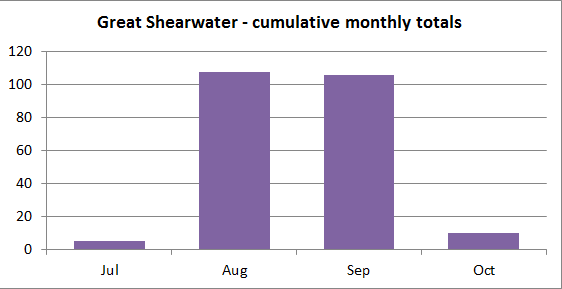Puffinus gravis
The majority, 128 birds, were seen from Strumble Head, a further 8 from the islands of Skokholm, Skomer, Ramsey and South Bishop combined.
For a species known to mainly travel well offshore it might be expected that the majority passing through the Irish Sea would be out of sight from land. Opportunities to detect these have been limited by the cost and availability of suitable boats and rough weather sometimes limiting their use. Despite these restrictions a total of 93 birds have been logged in the offshore waters of Pembrokeshire.
A group of 23 were flushed by the passing Fishguard to Rosslare ferry on the 15th September 1981. Five sightings of single birds were made from the Smalls during the autumn of 1982 – 84 when there were daily observations from the lighthouse. One was seen south of Caldey on the 4th August 1991 from the Cork to Swansea ferry. Three were seen from the Fishguard to Rosslare ferry on the 10th September 1999. Two were logged about 10 miles north of the Smalls on the 8th September 2006 from a ship on passage from the USA to Liverpool.
A total of 59 were encountered between 1998 and 2002 from shark–fishing vessels hired to visit the Celtic Deep area.
The largest incursions into our waters were in 1999 when a total of 41 was logged in the Celtic Deep compared to 11 inshore off Strumble Head and in 2002 when 17 were seen in the Celtic Deep and 29 recorded at Strumble Head.
 Monday, September 16, 2013 at 7:56AM
Monday, September 16, 2013 at 7:56AM 


